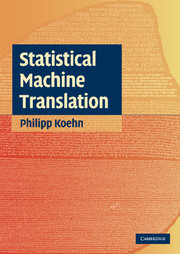7 - Language Models
from II - Core Methods
Published online by Cambridge University Press: 05 June 2012
Summary
One essential component of any statistical machine translation system is the language model, which measures how likely it is that a sequence of words would be uttered by an English speaker. It is easy to see the benefits of such a model. Obviously, we want a machine translation system not only to produce output words that are true to the original in meaning, but also to string them together in fluent English sentences.
In fact, the language model typically does much more than just enable fluent output. It supports difficult decisions about word order and word translation. For instance, a probabilistic language model pLM should prefer correct word order to incorrect word order:
pLM(the house is small) > pLM(small the is house)
Formally, a language model is a function that takes an English sentence and returns the probability that it was produced by an English speaker. According to the example above, it is more likely that an English speaker would utter the sentence the house is small than the sentence small the is house. Hence, a good language model pLM assigns a higher probability to the first sentence.
This preference of the language model helps a statistical machine translation system to find the right word order. Another area where the language model aids translation is word choice. If a foreign word (such as the German Haus) has multiple translations (house, home, …), lexical translation probabilities already give preference to the more common translation (house).
Information
- Type
- Chapter
- Information
- Statistical Machine Translation , pp. 181 - 216Publisher: Cambridge University PressPrint publication year: 2009
Accessibility standard: Unknown
Why this information is here
This section outlines the accessibility features of this content - including support for screen readers, full keyboard navigation and high-contrast display options. This may not be relevant for you.Accessibility Information
- 5
- Cited by
